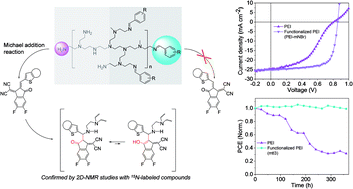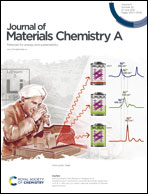Organic cathode interfacial materials for non-fullerene organic solar cells†
Abstract
Amine-containing polyelectrolytes such as polyethyleneimine (PEI) are commonly used as cathode interfacial materials (CIMs); however, they are rarely found in non-fullerene acceptor (NFA) organic solar cells due to undesirable chemical reactions between PEI and NFAs. Unveiling the nature of these chemical interactions and developing chemically stable amine-containing polyelectrolytes is inevitable for achieving highly efficient and stable NFA organic solar cells. Herein, the reaction between PEI and 2-(3-oxo-2,3-dihydro-1H-inden-1-ylidene)malononitrile (INCN)-based NFAs was investigated using a model system. 15N-isotope labeling experiments and 2D nuclear magnetic resonance (NMR) studies revealed that the products were generated by the Michael addition reaction and existed as the keto–enol tautomers. Based on the identified undesirable reaction, we developed a series of functionalized PEIs that are compatible with INCN-based NFAs by protecting the reactive amine functional groups. Highly efficient and stable NFA organic solar cells were successfully fabricated by the use of functionalized PEIs with broad work function tunability and improved chemical stability, which led to NFA organic solar cells with high power conversion efficiency (PCE) values of over 15% and thermally stable device operation for more than 360 hours at 100 °C.



 Please wait while we load your content...
Please wait while we load your content...